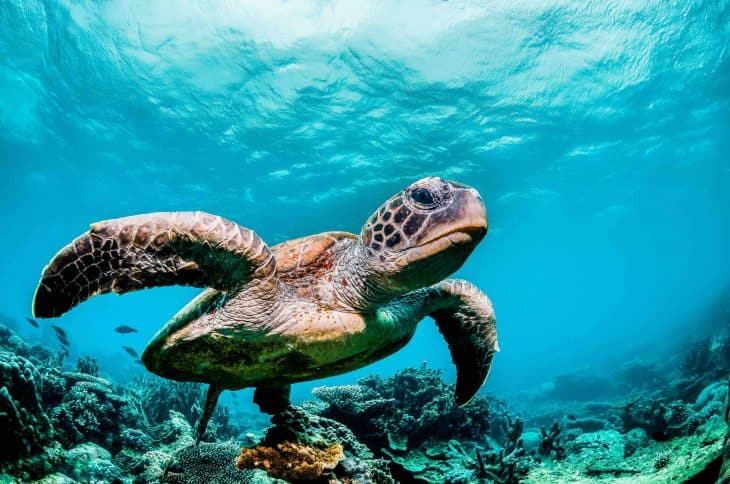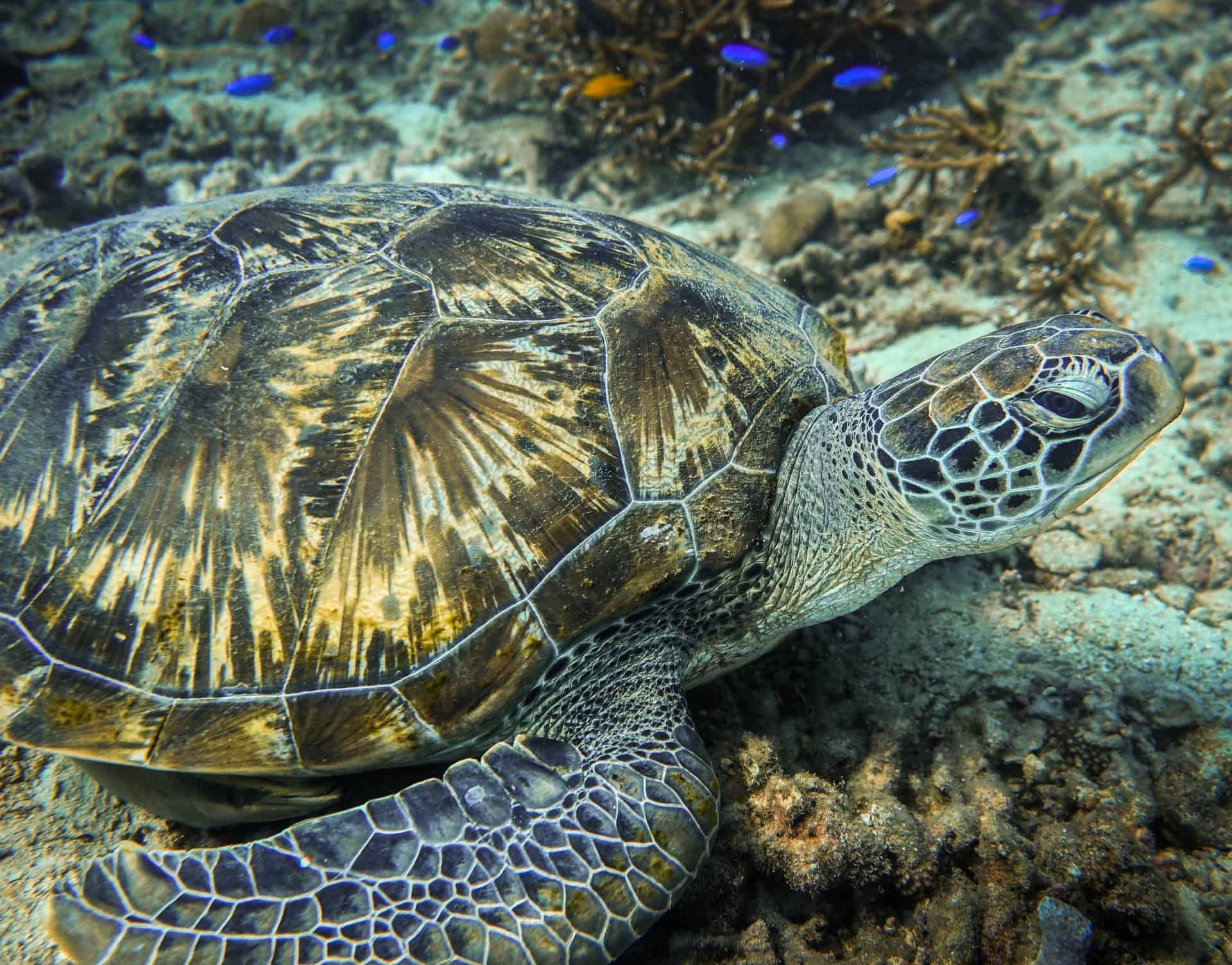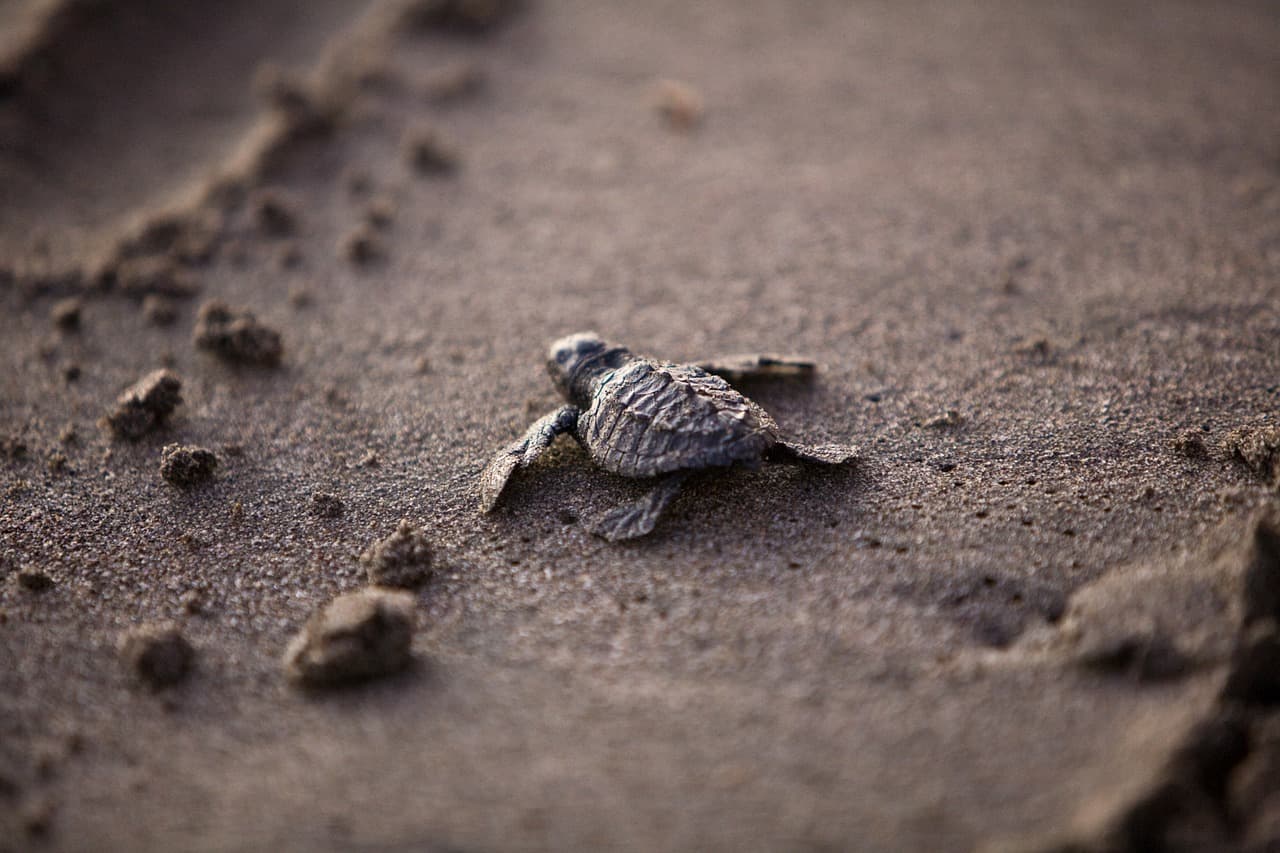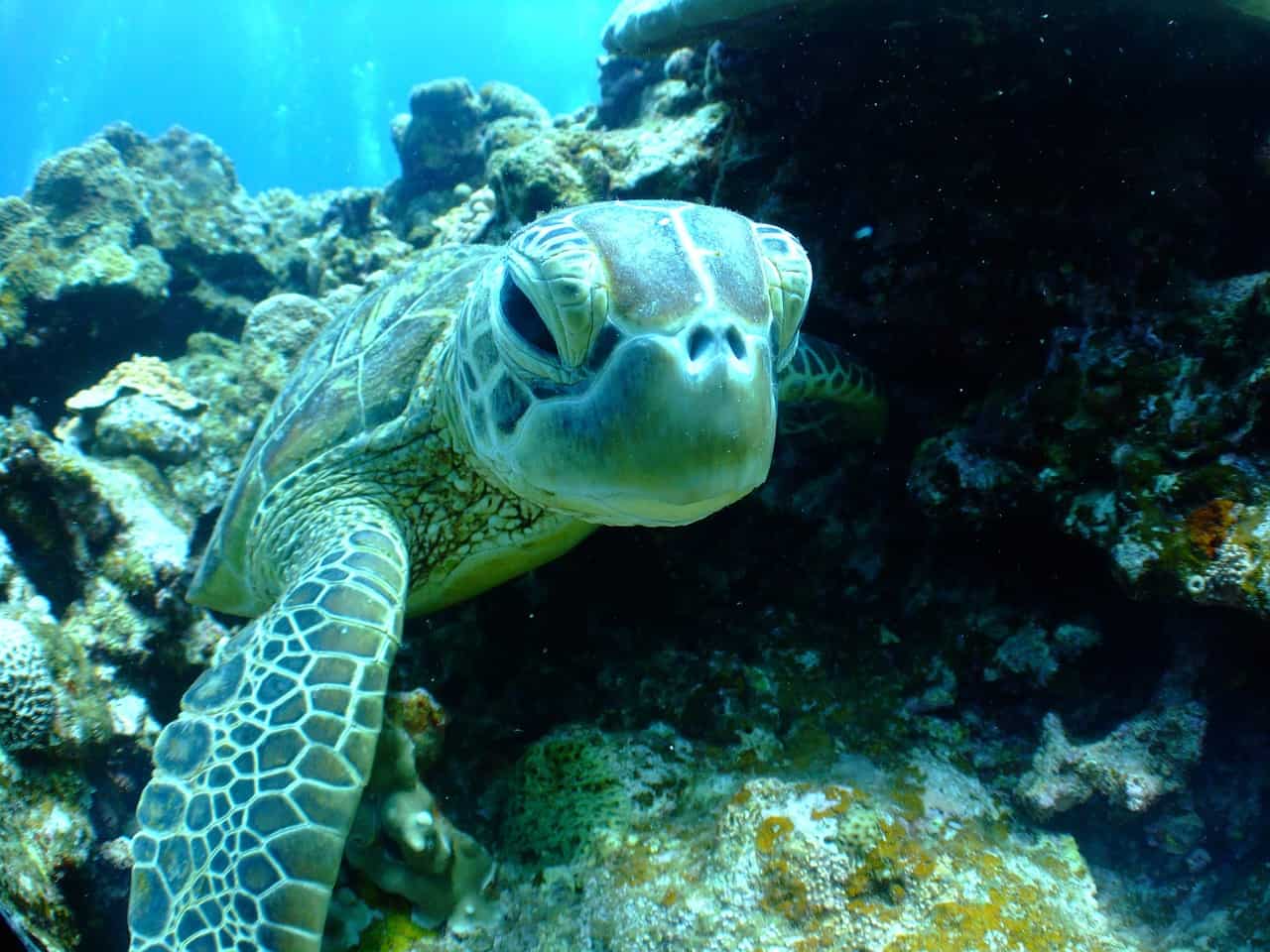
One of the majestic members of the turtle family are the sea turtles. Graceful in the water, sea turtles glide through the ocean with such ease and trek to far-flung beaches to secure the survival of their species. In U.S. waters, you’ll find six major species. There are the green turtle, hawksbill turtle, Kemp’s Ridley, leatherback, loggerhead, and Olive Ridley. However, they are all listed as endangered but protected under the Endangered Species Act. That’s undoubtedly one of the saddest sea turtle facts you’ll ever lay your eyes on.
Threats like human activities, climate change, marine debris, and oil spills have greatly affected sea turtles. Did you know that these ancient creatures have been on Earth for more than 100 million years? When the dinosaurs became extinct 65 million years ago, the sea turtles survived the catastrophe! After all this time, to have them die at the hands of cruel humans is quite horrifying. Other threats these marine reptiles face include entanglement, habitat loss, and consumption of their eggs and meat.
Here is another interesting thing about turtles. Turtles are often portrayed as slow and steady creatures. That’s true, but what isn’t often mentioned is their strength and endurance. Some sea turtles travel great distances, while others remain close to home. Leatherbacks and loggerhead turtles walk thousands of kilometers every year during migration. On the other hand, Hawksbill turtles rarely leave a small area.
There is a lot more to know about sea turtles. Check them out below and be amazed at our collection of sea turtle facts!
- There are seven existing species of sea turtles.
- The length of a sea turtle ranges from 2 feet or 24 inches to more than 6 feet or 72 inches.
- The smaller species of sea turtles weigh around 27 to 186 kilograms or 59 to 410 pounds.
- Although most of them swim at the speed of 5.8 meters per hour or 1.4 to 9.3 kilometers per hour, some sea turtle species can swim up to 35 kilometers per hour or 22 meters per hour.
- The origin of sea turtles can be traced to 150 million years ago.
- Marine turtle is the other term for sea turtle.
- Sea turtle belongs to the family Dermochelyidae (leatherback turtles).
- Sea turtles are reptiles.
- Sea turtles are part of the order of Testudines or any reptile that has a body encased in a shell.
- All six species of turtles can be found in U.S. waters.
- Depending on the species, sea turtles can be olive-green, greenish-brown, reddish-brown, or black.
- A group of sea turtles is referred to as bale.
- The scientific name of the sea turtle is Chelonioidea.
- Male and female sea turtles have the same size.
- Sea turtles inhabit all oceans except for the polar regions.
- Sea turtles use their limbs or arms to hold, swipe, or look for food.
- Sea turtles have specialized glands near their eyes. These glands produce tears to release excess saltwater.
- Sea turtles can recognize colors like violet, blue-green, and light-yellow.
- Sea turtles are toothless, but their jaws are powerful. They use these jaws to crush, bite, and chew food.
- Sea turtles often symbolize wisdom, patience, endurance, and good luck because of their long lifespan.
Sea turtles can live up to 50 years or more.
Sea turtles, just like the other turtle species, have a long lifespan. They can live up to more than 50 years. It also takes decades before a sea turtle becomes sexually mature, sometimes between 20 to 30 years. They remain productive for the next ten years.
The most noticeable characteristic of a sea turtle is its shell.
A sea turtle has a bony and large shell that protects them from predators and abrasion. The carapace is the top shell, while the plastron is the bottom shell. Their shells also have two layers. One layer contains flattened bone plates that grow and fuse with their ribs as they mature. The other one has keratin scales or scutes that protect them and prevent water loss.

Loggerhead sea turtles got their name from their huge and strong jaws.
Loggerhead sea turtles are one of the biggest, hard-shelled turtles. They got their names for their huge heads and strong jaws. They have heart-shaped, reddish-brown shells. Loggerheads use their front limbs to move through the water like wings, and their back limb to balance and maneuver. Typically, they weigh around 250 pounds or 113 kilograms and are about 3 feet or 0.9 meters long.
Leatherback turtles are one of the largest living turtles.
Leatherback turtles, also known as lute turtles or leathery turtles, are one of the biggest turtles. They are also one of the heaviest modern reptiles. They can easily be distinguished from other turtles because of their leather-like skin and lack of bony shells. In general, leatherback turtles weigh from 200 to 700 kilograms (440-1543 pounds) and can grow up to 7 feet or 2.1 meters.
Hawksbill sea turtles have long and narrow beaks.
Hawksbill, unlike the other species of sea turtles, are not particularly large. They grow to about 45 inches or 3.75 feet and weigh around 145 pounds or 65.77 kilograms. They have heart-shaped shells while they are young. These shells become elongated when they mature. One distinct characteristic of hawksbill is their long heads which resemble a bird’s beak.
One of the oldest sea turtles was said to be 400 years old.
Some sea turtles have outlived the estimated lifespan. One of the oldest living turtles was in Guangzhou Aquarium in China. It was said that the sea turtle was already 400 years old based on the shell test done by a taxonomic professor.
Kemp’s Ridley is the smallest species of sea turtles.
The smallest species of sea turtle is the Kemp’s Ridley. It grows to around 2 feet or 24 inches in length and weighs about 100 pounds or 45 kilograms. Kemp’s Ridley got its name from Richard M. Kemp, a fisherman who first reported on the species in 1906. Kemp’s Ridley usually inhabits the Gulf of Mexico, though some also live in the Atlantic Ocean.

Food preference of turtles depends on their species.
The food that sea turtles eat varies based on their species. They can be omnivores or herbivores. Hawksbill sea turtles prefer to eat mollusks, anemones, and crustaceans. Loggerheads are carnivorous and feed mainly on food that they can easily chew or eat like crabs and sea urchins. Kemp’s Ridley prefers fish, crabs, and a variety of mollusks.
Green sea turtles have greenish skin.
The green sea turtle got its name not because of the color of its shell, but because of its greenish skin color. They are one of the biggest sea turtles. They weigh around 700 pounds or 317 kilograms. Green sea turtles have small heads, which they cannot draw back from their heart-shaped shells.
There are two types of green sea turtles.
The two types of green sea turtles are the Atlantic green turtle and the East Pacific green turtle. The Atlantic green turtle lives on the shores of Europe and North America. The East Pacific green turtle inhabits the coastal waters from Alaska to Chile. The green sea turtles are also known as the green turtle, black (sea) turtle, or Pacific green turtle.
Sea turtles eat jellyfish.
Sea turtles, especially leatherback turtles, eat jellyfish. Like other land turtles, sea turtles eat anything that their mouths can grab on. The easiest food to catch in the oceans is jellyfish. Contrary to what most people believe, sea turtles do not get any chemical buildup from jellyfish that will intoxicate them or make them feel high.
Jellyfish do not sting sea turtles.
Do you wonder if sea turtles get stung while eating jellyfish? Sea turtles have developed adaptations that allow them to eat jellyfish without getting stung. The scales of the sea turtles protect them from the venom of jellyfish. They have papillae or small, nipple-like structures in their mouth up to their esophagus that help break down their prey once eaten.
Leatherback sea turtles can catch jellyfish in just 22 seconds.
Leatherback sea turtles can catch jellyfish as fast as 22 seconds and consume them in just one minute. Leatherback turtles can also snatch a dozen of jellyfish in a quick sequence and leave nothing behind.
Female sea turtles lay their eggs on the beach.
A mature sea turtle drags herself onto the beach, usually at night. There she will look for a spot to create a nest. A sea turtle usually digs a hole around 40 to 50 centimeters (15-19.6 inches) deep). Afterward, she will lay around 50-350 soft-shelled eggs, depending on the species. After laying eggs, she will cover the nest with sand and will go back to the ocean. The whole process may take around 30 to 60 minutes.
Sea turtle eggs incubate within 50 to 60 days.
Sea turtle’s eggs will incubate within 50 to 60 days. Over a short time, the eggs in one nest will hatch together. The baby turtles will use their beaks to break the eggshells, dig into the sand, and crawl to the ocean. They usually hatch at night because they are less vulnerable to predators. However, the Kemp’s Ridley turtle commonly conceives during the day.

Sea turtles can hold their breath for 45 minutes to 1 hour.
Just like other reptiles, sea turtles have lungs. It is why they have to go to the surface to breathe air in between dives. Amazingly, sea turtles can hold their breath for 45 minutes to 1 hour if they are active. Some of them can hold their breath for up to 2 hours while resting or sleeping.
Five species of sea turtles nest on South Padre Island.
South Padre Island, a resort in Cameron County, Texas, is an island inhabited by sea turtles. All five species of sea turtles including Kemp’s Ridley, the green sea turtle, leatherback, loggerhead, and hawksbill can be found here. There is also a rehabilitation center on the island that monitors, rescues, rehabilitates, and releases injured sea turtles.
Most sea turtles are subject to temperature-dependent sex determination.
Most turtles have temperature-dependent sex, which means that the sex or gender of a baby turtle will depend on the temperature it is exposed to. Cooler temperatures produce male hatchlings, while hotter or warmer temperatures produce females. Based on research, if the sea turtle’s eggs incubate below 81.86ºF (27.7ºC), hatchlings will become male. Meanwhile, those that incubate above 87.8°F (31ºC) will conceive females.
Climate change may cause the death of sea turtles.
Climate change has an enormous impact on sea turtles and other marine animals. Frequent and severe storms may cause beach erosion that will flood sea turtle nests. Hot sands, for instance, can affect the natural sex ratio and will produce more females. Moreover, climate change also has a major impact on coral reefs, which are important to the survival of sea turtles.

Sea turtles play an important role in oceans and beaches.
Sea turtles have vital roles in their habitats. In the oceans, sea turtles graze on seagrass. Through this, they help maintain the health of seagrass beds. Also, the hatched or even the unhatched eggs that fail to reach the ocean become a good nutrient source for dune vegetation.
Was this page helpful?
Our commitment to delivering trustworthy and engaging content is at the heart of what we do. Each fact on our site is contributed by real users like you, bringing a wealth of diverse insights and information. To ensure the highest standards of accuracy and reliability, our dedicated editors meticulously review each submission. This process guarantees that the facts we share are not only fascinating but also credible. Trust in our commitment to quality and authenticity as you explore and learn with us.
